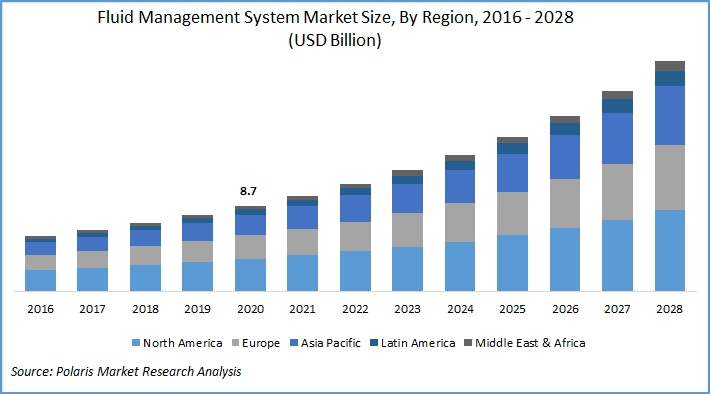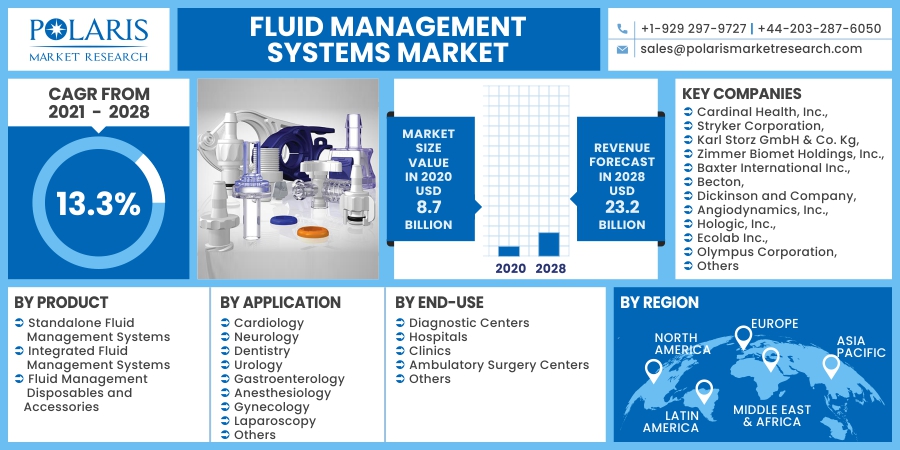
Fluid Management Systems Market Share, Size, Trends, Industry Analysis Report, By Application (Cardiology, Neurology, Dentistry, Urology, Gastroenterology, Anesthesiology, Gynecology, Laparoscopy, Others); By Product; By End-Use; By Regions; Segment Forecast, 2021 - 2028
- Published Date:Mar-2021
- Pages: 108
- Format: PDF
- Report ID: PM1827
- Base Year: 2020
- Historical Data: 2016 - 2019
Report Outlook
The global fluid management system market size was valued at USD 8.7 billion in 2020 and is expected to grow at a CAGR of 13.3% during the forecast period. Fluid management systems are used for the control and supervision of body fluid levels during various medical procedures. These systems assist in the maintenance of required liquid levels in the body.
Fluid management systems offer functionalities such as warming and filtration, deficit monitoring, and irrigation, among others. Fluid management systems are used in several applications such as cardiology, neurology, urology, gastroenterology, laparoscopy, among others.

Know more about this report: request for sample pages
The demand for fluid management systems has increased for control and administration of liquids such as blood, electrolytes, and saline required during medical procedures. Fluid management systems play a major role in measuring deficit during procedures to provide improved patient safety. These machines are designed to minimize and recognize general absorption of liquid.
The global fluid management system market is fueled by growth in countries such as China, Japan, and India, rising healthcare expenditure, and changing lifestyles. Global players are expanding into developing countries to tap market potential, further boosting the market growth. Technological advancements and established R&D institutes further support the market growth.
Industry Dynamics
Growth Drivers
New product launches and acquisitions by leading players in the market coupled with technological advancements have increased the demand for fluid management systems across the globe. In August 2018, Hologic, Inc. introduced a Fluent management system in the United States. The device is developed to provide liquid management for hysteroscopic procedures.
The fluid management system is fitted with the FloPak technology and a single waste bag design for the regulation of liquid monitoring during hysteroscopic procedures. The new product is aimed at enhancing the company’s product portfolio and catering to the growing market demand for efficient management equipment.
The market is experiencing growth owing to the increasing geriatric population, rising cases of lifestyle diseases, and growing need to provide enhanced patient experience. There has been significant growth in demand for minimally invasive surgeries, further driving the growth of the market. The healthcare industry worldwide is attracting significant investments to improve the healthcare infrastructure and develop technologically advanced medical products.
Increasing demand for endosurgical procedures, growing use of single-use disposable products, and rising demand from developing countries are some factors fueling the market growth. Governments across the globe are introducing strict healthcare regulations, encouraging market players to develop effective and patient-friendly management systems.

Know more about this report: request for sample pages
Fluid Management System Market Report Scope
The market is primarily segmented on the basis of product, application, end-use, and region.
|
By Product |
By Application |
By End-Use |
By Region |
|
|
|
|
Know more about this report: request for sample pages
Application Outlook
On the basis of application, the market is segmented into cardiology, neurology, dentistry, urology, gastroenterology, anesthesiology, gynecology, laparoscopy, and others. The urology segment dominated the global market in 2020. There has been a high demand for liquid management systems from this segment owing to increasing demand for dialysis, growing geriatric population, and technological advancements.
Product Outlook
The product market segment has been divided into standalone fluid management systems, integrated fluid management systems, and fluid management disposables and accessories. The standalone fluid management system accounted for a major share of the global market.
The standalone fluid management system includes insufflators, fluid warming systems, dialyzers, and fluid waste administration devices, among others. The increasing geriatric population, growing demand for minimally invasive surgeries, rising research and development activities, and technological advancements are some factors attributed to the market growth of this segment.
End-Use Outlook
On the basis of end-use, the market is segmented into diagnostic centers, hospitals, clinics, ambulatory surgery centers, and others. The hospital market segment dominated the global fluid management system market in 2020. The fluid administration system is used in a wide range of applications in a hospital. The high traffic environment, advanced healthcare infrastructure, availability of varied medical devices, and presence of experienced medical professionals in hospitals support the growth of this segment.
Regional Outlook
North America dominated the global market in 2020. The increasing geriatric population, the occurrence of chronic diseases, growing research and development activities, and technological advancements are some factors stimulating the growth of this market segment. The increasing demand for minimally invasive surgeries established healthcare infrastructure and increasing adoption of disposable accessories drives the growth in this region. Changing lifestyles coupled with increasing cases of cancer have increased the demand for fluid administration systems in the region.
Competitive Landscape
The leading players in the market include Cardinal Health, Inc., Stryker Corporation, Karl Storz GmbH & Co. Kg, Zimmer Biomet Holdings, Inc., Baxter International Inc., Becton, Dickinson and Company, Angiodynamics, Inc., Hologic, Inc., Ecolab Inc., Olympus Corporation, Medtronic PLC, Fresenius Medical Care AG & Co. KGaA, B. Braun Melsungen AG, Johnson & Johnson, and Smiths Group PLC.
